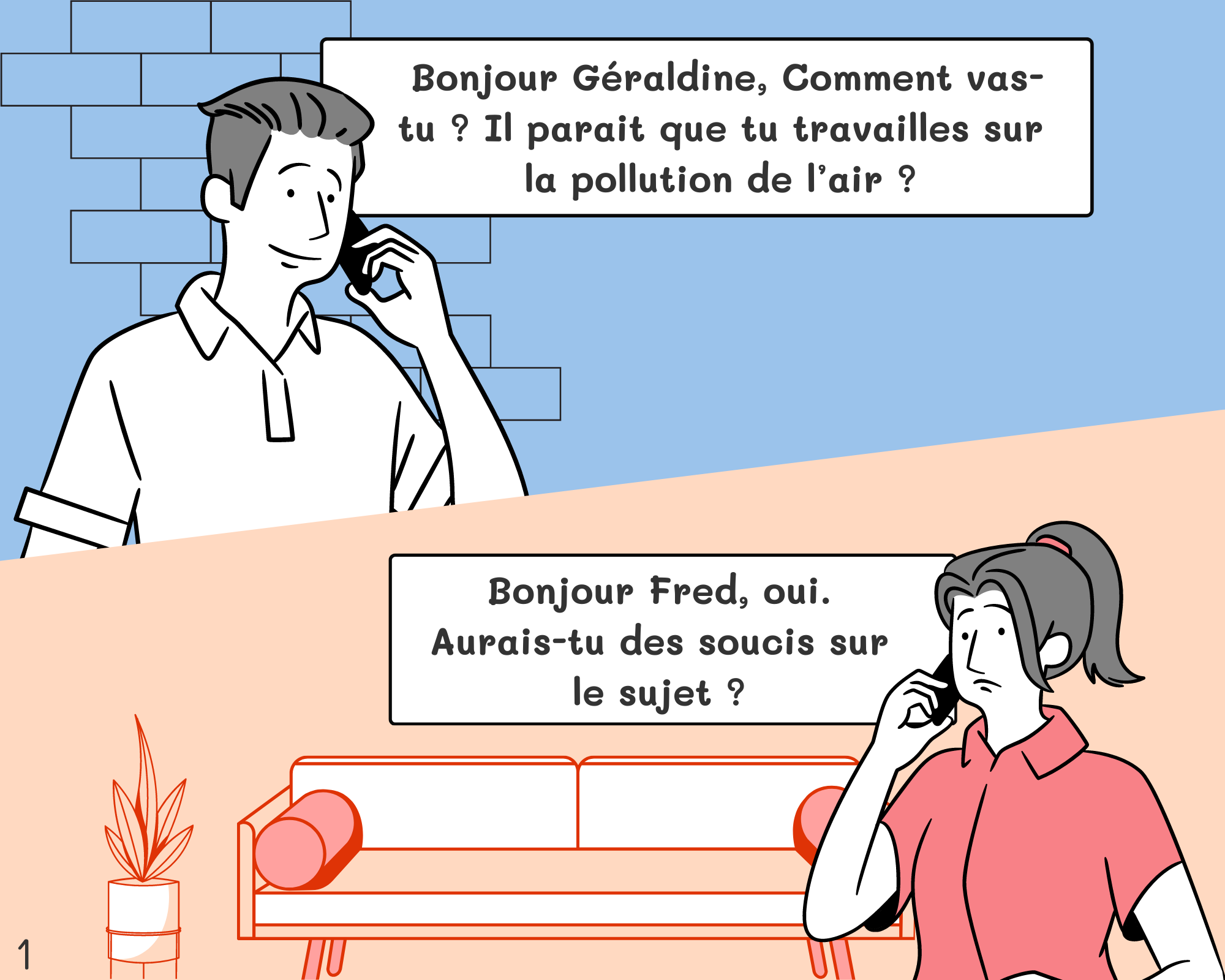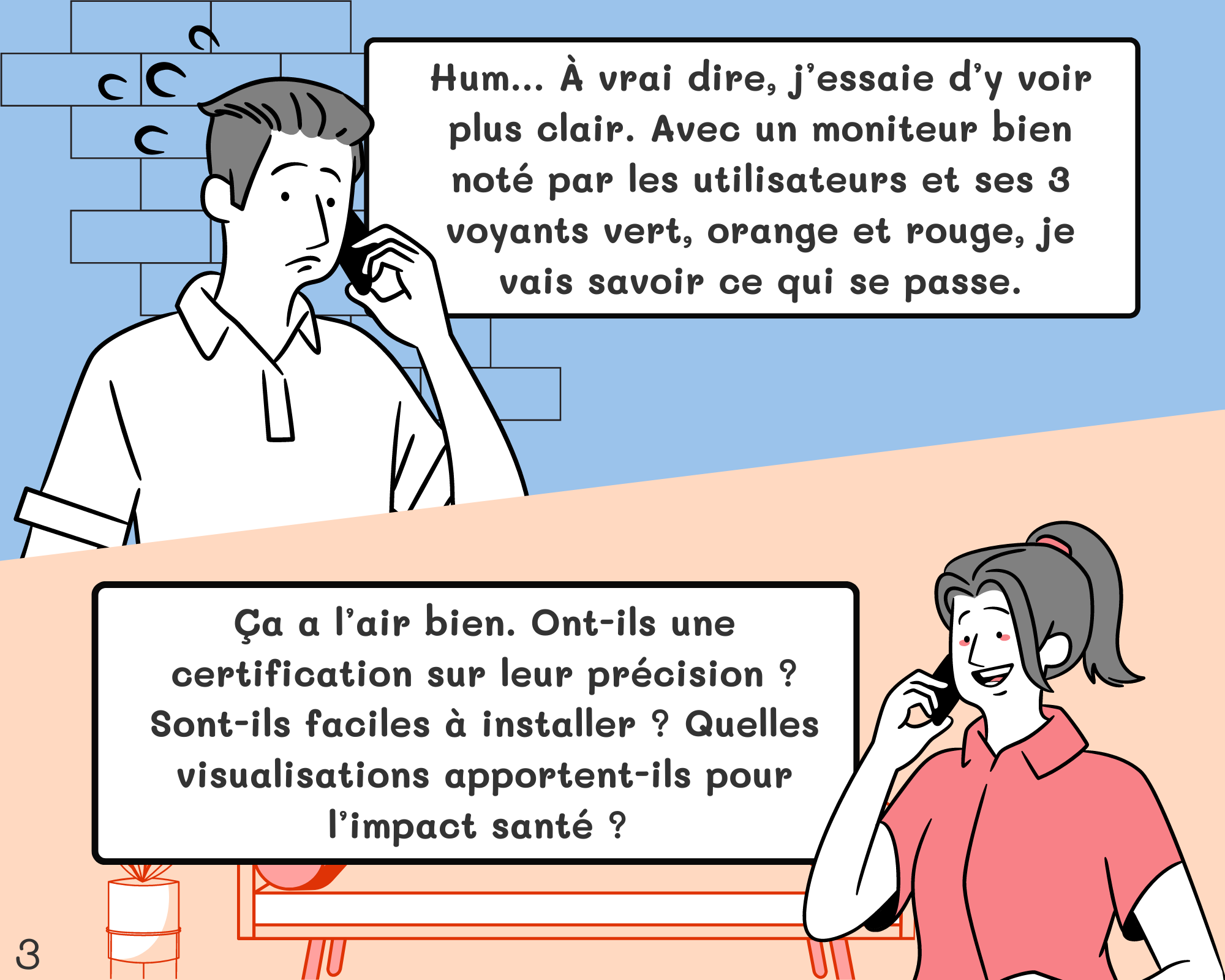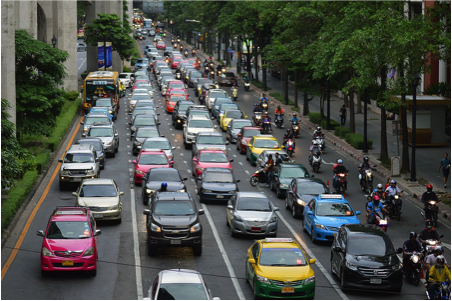



Research in London conducted by Enviro Technology Services using the Air Quality Monitoring vehicle –also known as the ‘smogmobile’, has shown that NO2 was on average 21% higher inside vehicles than outside. Dr. Ben Barratt, air quality researcher at Kings College in London, mentioned that these research findings add to the already existing evidence that vehicles do not protect against air pollution. In fact, he called on the need to better understand the health effects of this high pollution exposure for those who spend vast amounts of time in a car, such as taxi and bus drivers. Another recent research by El-Fadel M and Abi-Esber L also showed that exposure in-vehicle to VOC and PM2.5 is high, that the ventilation mode greatly contributes to the exposure, that 3 out of 6 cars have instrusion of own engine fumes and that air pollution was higher inside new cars than outside. In fact, taxi and bus drivers have 5 times more exposure to bad air quality than people who work elsewhere.
A number of studies have been conducted in the past 10+ years on Volatile Organic Compounds (VOC) inside new cars. In fact, that attractive ‘new car’ smell, is off-gas derived from a mix of materials used in the treatment of leather, dashboards and seats, in addition to the glues.
There can be 50-100 VOC individual compounds in any given car, including bromine, chloride, phtalates, lead and heavy metals. All of which, according to Jeff Gearhart -research director at the Ecology Center, have been linked to cancer, birth defects, allergies, liver toxicity and impaired learning.New cars have VOC concentrations above the indoor permissible levels, but luckily they fade away in the first 6 months of a car’s life.Heat can increase these concentrations considerably.

In addition to VOCs, studies which have been conducted to look into the air quality inside the cars, have found that there is also high concentration of PM2.5 and higher concentrations of carbon monoxide, benzene, toluene and fine particulate matter than in road-side monitoring stations. Moreover, studies have also found high concentrations of mould spores and bacterial endotoxins, which may induce major respiratory symptoms, allergies and are of concern to asthmatics.
– Ensure car ventilation to decrease the inside VOC at a faster rate, specially in the first 6 months of a car. Either have the windows down or use air conditioning regularly.
– Use air re-circulating options when stuck in traffic to avoid excessive amounts of engjne exhaust fumes coming into the car.
– Use air conditioning to control humidity and reduce mould spores and bacterial microorganisms.
– Avoid accumulation of dust, moisture/mould or residual cigarette smoke.
Sources:
Explorations of everyday chemical compounds – The Chemicals Behind the ‘new car smell’.
Productivity across all levels of employment matters and business leaders struggle to make sure it is optimized by investing in training, team building, office settings, freebies and many other proven strategies. However, 15 years of research has shown a close link between air quality and productivity that are the basis for green buildings and better indoor air management.
For many years we have known about the sick building syndrome (SBS), which are the common ailments that arise from time spent in a particular building and being exposed to poor ventilation or air filtration, outgasses from building materials, volatile organic compounds (VOC) and molds. Common ailments resulting from SBS are: headache, dizziness, nausea, eye, nose or throat irritation, dry cough, itchy skin, poor concentration, fatigue, voice hoarseness, allergies, cold, increased asthma and flu-like symptoms. And it all escalates to affect our congnitive capacity and productivity. So efforts to reduce both indoor and outdoor air pollution are actually investments in productivity, human capital and economic development.
The earliest known research on air quality and productivity dates back to 1999. Since then many studies on packers, call centers, farmers and even football players have confirmed that poor air quality has a negative effect on productivity, both indoors and outdoors.



In 2011, the National Bureau of Economic Research looked at farm workers output and ozone levels. They found that a decrease of 10ppb in Ozone concentrations increases worker productivity by 4.2%. Overall the research found that even at lower levels of Ozone than the standard, there were negative impacts on productivity and its strict regulation would yield benefits in health, productivity and possibly other areas. This was followed in 2014 by a research at Columbia, the University of South California and the University of California-San Diego where researchers looked into the effect of PM2.5 on pear-packers in California. It was found that just a 10 unit increase in PM2.5 decreased productivity by approximately 6% and that productivity is affected even below US standards. Moreover, Harvard University researchers recently assessed the effect of air quality in knowledge workers, those who are indoors mostly in front of a computer throughout their work day. They analysed Ctrip productivity in China against indoor air quality and found that workers are 5-6% more productive when air pollution is 0-50 AQI compared to 150-200 AQI. In a separate research by Harvard and Syracuse University, researchers looked into VOCs, CO2 and productivity. In addition to confirming the negative effect of air pollution on cognitive function, they specifically found that the greatest change (up to 15%) was observed in those cognitive functions involved in crisis response, information usage and strategy.
This body of research has shown how important it is to look into ways to improve indoor air quality. John Mandyck, chief sustainability officer for the NYSE listed United Technologies Corporation (UTC) said:

So what can we do with all those buildings that are old or just not green?
Let’s:
Sources:
NIH – The Sick Building Syndrome
Harvard Business Review – Air Pollution is Making Office Workers Less Productive
INSIDER – The pollution outside your office window affects your work.
EPA – An Office Building Occupants Guide to Indoor Air Quality
The World – Want better thinking and productivity? Improve the air quality in your office.
Air pollution is becoming more and more present in the news, in casual conversations, in the promotion of products and in many more instances. However, are we all talking about the same thing? What exactly is it that we all call ‘air pollution’?
Air pollution is a mix of natural and man-made substances in the air we breathe which is harmful to our health, it can be any physical, chemical or biological agent that modifies the natural atmosphere. Most sources of air pollution are man-made from mobile sources such as fuel powered motor vehicles; and stationary sources such as factories, refineries, power plants and forest fires. There are also other indoor sources such as building materials and cleaning products. Air pollution, as we now know is present both outdoor and indoor.
Gases emanating from:
The World Health Organization (WHO) in 2005 issued the ‘WHO Air Quality Guidelines’ to offer guidance and limits for the most worrying air pollutants because of their threat to human health, their widespread presence in urban areas and their relevance as precursors for other toxic components: particulate matter (PM10, PM2.5), ozone (O3), nitrogen dioxide (NO2) and sulphur dioxide (SO2).
Is a mix of solid and liquid (organic or inorganic) particles suspended in the air. It is the pollutant that affects most people and is generally composed by sulphate, nitrates, ammonia, sodium chloride, black carbon, mineral dust and water.
Ground-level Ozone is a major component of smog, formed by the reaction of sunlight with nitrogen oxides (NOX) and volatile organic compounds (VOCs).
NO2 is mostly the result of emissions during the combustion process (power generation, heating and engines). It is in fact, a source of nitrate aerosols that form PM2.5.
SO2 is produced from fossil fuel burning for domestic use, power generation or motor vehicles
Other components generally referred to when talking about air pollution are carbon monoxide (CO), carbon dioxide (CO2) and volatile organic compounds (VOCs), which has greater relevance when talking about indoor air pollution, although also present outdoors.
VOCs are a collection of toxic gases from solids or liquids, that are found in higher concentrations indoors (up to ten times higher). Thousands of products used indoors as construction materials, paints, varnishes, cleaning agents, activities like cooking and many more, are the source of VOCs while being used and while stored. (6) Safe levels / guidelines for exposure to VOCs are not known,, but common sense rules are that they should be kept at low levels to avoid or reduce their negative health effects, which have been well documented.
CO and CO2 are not considered as VOCs. They are both odorless, tasteless and harmful to human health but have clear differences – CO2 occurs naturally in the atmosphere and we can tolerate it in small amounts, whereas CO can cause problems even in low concentrations and is flammable.
Sources:
NIH – Air Pollution and Your Health
EPA – Pollutants and Sources
WHO – Air Pollution
WHO – WHO Challenges World to Improve Air Quality
WHO – WHO Guideline for Particulate Matter, Sulphur, Ozone…
EPA – Volatile Organic Compounds’ Impact on Indoor Air Quality
So much is said about the appalling air pollution in China, how its citizens suffer and how only the rich can take adequate protective measures. But so little has been said about how we may all be linked to this pollution, even if we have never set foot in China.
Researchers from Tsinghua University, University of California and other institutions have recently published a paper with very interesting data on how we all bear the brunt of air pollution in China and how pollutants aided by global air currents reach neighboring countries and affect the health even of those who leave in distant territories. This gives us an idea of the uncontrollable and controllable components of air pollution.


This research looked at PM2.5 (fine particulate matter) in 13 regions across 228 countries, and found that 12% of premature deaths (410,000) globally result from pollutants emitted in a different country, but which are often moved around by global wind conditions. While this result shows us how difficult it is to run away from air pollution that sees no real borders, it definitely makes us see the relevance of monitoring air quality regardless of how far we live from sources of pollution.
At the same time, this study explains how we all bear the brunt of air pollution in China and other countries of Asia. In fact, 90% of air pollution-related global mortality comes from power stations, airplanes, shipping and factories. All elements that constitute global trade. The ever-expanding nature of markets have made cheap products that flood western markets, the basis of a considerable amount of pollution in the East: China, India, Indonesia etc.
Cheap products are produced in Asian countries for a number of reasons – cheap labor and a lack of environmental regulations, which means that the process of production is highly contaminated and contributes to air pollution not to mention water or soil contamination. In addition, these products are produced far away from the place of their consumption so shipping and airplanes need to be heavily used to freight them to their end users.
Dr Qiang Zhang, one of the researchers, revealed that in 2007 consumption in the United States and Western Europe was tied to 110,000 premature deaths in China. In fact, the minute we buy cheap products, we are unconsciously increasing our share in air pollution.


“If the cost of imported products is lower because of less stringent air pollution controls in the regions where they are produced, then the consumer savings may come at the expense of lives lost elsewhere,”
This is why their main message is:
“We need to move our lifestyles away from cheap and wasteful,” Qiang Zhang
This research clearly shows the need to measure air quality and act to protect ourselves, regardless of how far we live from the source of pollution. And secondly, makes us understand how our consumption patterns can make a difference in the air quality suffered in other regions of the world.
Sources:
The Guardian – Thousands of pollution deaths worldwide linked to western consumers
HuffPost – Air Pollution Links People Thousands Of Miles Apart In Deadly Ways
The Economist – Airborne particles cause more than 3m early deaths a year
Nature – Transboundary health impacts of transported global air pollution and international trade
Previous research had shown a correlation between increased pollution and Alzheimer’s disease; between developing brains exposed to air pollution and mental health; and a link between air pollution and cognitive function in older men. Researchers are increasingly looking at these links and gathering evidence on yet another health effect of the polluted air we are exposed to.
The olfactory system is a direct route for small particles into the brain, especially those small enough to escape through the olfactory bulb. We have recently talked about the link between air pollution and strokes, now a new research from Lancaster University published by the Proceedings of the National Academy of Science has found evidence of toxic nano-particles, which come from air pollution, in human brains and has led to a rich discussion on the possible link between air pollution and Alzheimer’s disease.


In this most recent research, which examined brain tissue from 37 persons from Mexico and Manchester (UK), toxic nano-particles from air pollution -particularly magnetite, have been found in the human brain along with platinum, cobalt and nickel. According to the researchers, the shape and the type of metal indicates that it can only have come from air pollution. Accumulation of metals in the brain is characteristic in Alzheimer’s disease and especially magnetite, which has been previously associated with brain damage in patients with such ailment.
Many scientists have commented on the research results and although it is undisputed that the metal nano-particles in the brain do come from air pollution, many consider that this is not proof that there is a link between air pollution and Alzheimer disease.
Nonetheless, the study explains how the route of these nano-particles into the brain is through the olfactory system. Those particles that are small enough to pass through the olfactory bulb to the brain can lodge in the brain, cortex, hippotalamus and many others almost without barriers. Particles that lodge deep in your lungs can be very damaging because they create inflammation, infection, cancer or go directly to the bloodstream to cause trouble in other parts of the body. However, particles that enter through the olfactory system can be even more damaging because they have direct entrance to the brain where they can damage or kill neurons or even hamper the bains’ immune system.
In fact, both the Alzheimer’s and Parkinsons disease present a loss of the olfactory system capacities very early on. For this reason, many recent studies look at those particles that can be inhaled and have a direct pathway to our brains. One in every 14 persons above 65 suffer from Alzheimer’s diseases.
September is the World Alzheimer’s month, we cannot ascertain that air pollution is linked to Alzheimer, but we can raise awareness on the direct route for nano-particles into our brain.
Protect yourself and your family from air pollution!
Sources:
There has been an intense debate over the possible link between breast cancer and air pollution. FIGO- the International Federation of Gynecology and Obstetrics highlighted the discovery of a link between air pollution and breast cancer following an article published in the Breast Cancer Journal on the results of research conducted by the University of Florida. This was reported by mainstream media as an alarming call to women living in areas with high air pollution.
But there is no need to panic, it’s very important to be cautious with scientific results. In fact, many organizations like Cancer Research-UK, BreastCancer and others jumped to clarify that finding a link does not mean that air pollution causes breast cancer. Two things can be highly correlated without implying causation.
We know and we’ve talked about how pervasive air pollution is in our bodies, affecting our lungs, circulation, diabetes, skin and many more. The link between air pollution and lung cancer is very well researched, many research teams have worked on this subject for decades and have found how it happens and why. All the other links of air pollution to diseases are still in the very beginning of compiling research results and while it is one thing to link air pollution with skin problems, it is another step entirely to link it with a life-threatening disease like breast cancer.
We should not panic, but we should know the extent of current research on this matter. The latest research was conducted by the University of Florida, US, and looked at the link between breast density and air pollution. They found that women living in areas with high pollution had denser breast tissue. Women with dense breast tissue are up to six times more likely to develop some form of breast cancer.
In 2010, another study by the Research Institute of the MUHC, McGill University and Université de Montreal also showed a link. This study mapped air pollution against breast cancer patients and found that women living near areas with higher levels of pollution were twice as likely to develop breast cancer than the rest. However, Dr Goldberg, a researcher at The RI MUHC said:
“For example, we don’t know how much the women in the study were exposed to pollution while at home or at work, because that would depend on their daily patterns of activity, how much time they spend outdoors and so on”
In the case of this study, what is interesting is that the motivation to study the link between air pollution and breast cancer was to try to understand why cancer rates were going up in general / in these particular high pollution areas. The results showed that it could be air pollution but it may well be some other factor that the study could not control. In fact, the researchers called for more research on this subject and more research on the biological explanation behind this possible link.